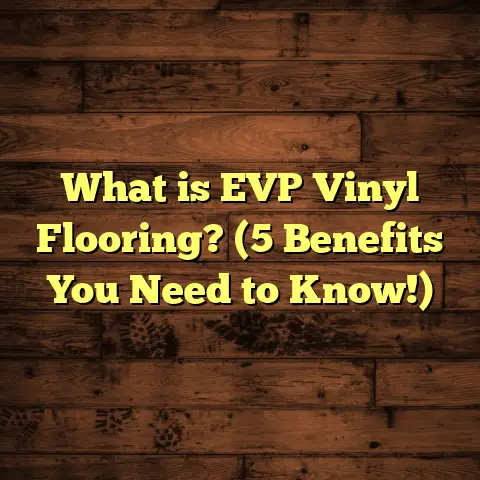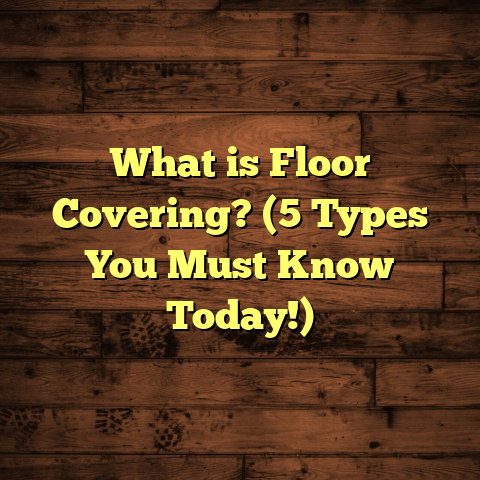What is My Floor Made of Black Squares? (5 Material Insights)
Versatility is something I really appreciate when it comes to flooring. Floors not only have to hold up to daily wear and tear but also need to fit the style and feel of a space. One type of flooring that often catches my eye—and probably yours too—is the floor made of black squares. It’s bold, sleek, and can completely change the vibe of a room. But what exactly are these black squares made from?
What Are These Black Square Floors Made Of?
When I first encountered floors covered in black squares, I was curious. Are they tiles? Vinyl? Or something else entirely? The truth is, black square flooring can be made from several materials, each with its own look, feel, durability, and price point.
From my experience working on different projects and chatting with clients, here are five common materials that black square flooring might be made of:
- Ceramic or Porcelain Tile
- Vinyl Composition Tile (VCT)
- Rubber Flooring Tiles
- Laminate Flooring Tiles
- Natural Stone Tiles
Let me walk you through each one, sharing what I’ve learned and recommended based on real-world use.
Ceramic or Porcelain Tile
When you think about black square floors, the first material that pops into many minds is ceramic or porcelain tile. I’ve installed these a lot, especially in kitchens and bathrooms where moisture resistance is key.
Why choose ceramic or porcelain?
These tiles are fired at high temperatures, making them extremely durable and water-resistant. Porcelain tiles tend to be denser and less porous than ceramic, so they’re even tougher.
My Experience with Ceramic/Porcelain Black Tiles
One kitchen renovation I handled featured 12×12 inch black porcelain tiles with a matte finish. The homeowner loved how easy it was to clean—just a quick mop or wipe was enough. Plus, the tiles resisted stains and scratches well.
I remember early in my career trying glossy black ceramic tiles in a small bathroom. While they looked stunning under certain lighting, they were a nightmare to keep spotless because fingerprints and water spots showed up immediately. Since then, I’ve preferred matte or textured finishes for black tiles to minimize visible dirt.
Data Point: Lifespan and Durability
According to industry stats, ceramic and porcelain tiles can last upwards of 50 years with proper care. That’s impressive for a floor! Plus, porcelain’s water absorption rate is less than 0.5%, which means it won’t soak up spills and stains.
The hardness of these tiles is measured on the Mohs scale between 6 and 7, making them resistant to scratches from pets or furniture. However, they can chip if heavy objects are dropped on them.
Installation Insights
Installation of ceramic or porcelain tile requires a stable subfloor and skilled labor. I’ve seen some DIY attempts where uneven subfloors caused cracking later on. Using a proper cement backer board and leveling compounds makes all the difference.
Grout choice also impacts maintenance—dark grout hides stains better but can fade over time, while light grout can require more cleaning but brightens the overall look.
Pros and Cons
| Pros | Cons |
|---|---|
| Extremely durable | Can be cold underfoot |
| Water and stain resistant | Installation requires skill |
| Wide variety of finishes | Hard surface can be uncomfortable |
| Easy to clean | Can crack if subfloor is unstable |
For those who want a long-lasting, classic look, these tiles often fit the bill perfectly.
Vinyl Composition Tile (VCT)
VCT is a material I’ve used often in commercial spaces like schools and hospitals, but it’s also gaining popularity in homes for its affordability and design options.
VCT usually comes in 12×12 inch black squares and is made from colored vinyl chips formed into sheets or tiles.
Why Does VCT Work Well?
I remember a client who wanted black square floors in their basement rec room but had a tight budget. VCT was perfect—it mimicked the look of tile but cost less and was easier to install over existing subfloors.
It’s also very forgiving when it comes to unevenness. VCT doesn’t crack like ceramic would under slight movement.
Maintenance and Longevity
VCT needs regular polishing to keep its sheen, but it’s pretty resilient against heavy foot traffic. According to manufacturers, VCT floors can last 15–20 years if maintained well.
During one commercial project for a local school gymnasium, VCT held up well despite intense foot traffic and sports equipment being dragged across it daily. The school custodian did weekly stripping and waxing cycles that preserved the floor’s appearance remarkably well.
Environmental Considerations
One thing clients sometimes ask me about is whether vinyl flooring is eco-friendly. Traditional VCT contains PVC which isn’t biodegradable. But newer options include recycled content and low-VOC adhesives that reduce environmental impact.
Pros and Cons
| Pros | Cons |
|---|---|
| Cost-effective | Requires regular waxing/polishing |
| Easy to replace damaged tiles | Can yellow over time |
| Durable for moderate traffic | Not as water-resistant as ceramic |
| Quick installation | Potential off-gassing odors initially |
If you’re thinking about a budget-friendly option that still handles wear well, VCT is worth checking out.
Rubber Flooring Tiles
Rubber tiles aren’t just for gyms or playgrounds—they’re becoming popular in kitchens and workspaces where comfort underfoot matters.
What’s So Special About Rubber?
I installed black rubber tiles in a home gym recently. The homeowner loved how soft the floor felt underfoot but still found it easy to clean after sweaty workouts.
Rubber tiles come in squares ranging from 12×12 to 24×24 inches and offer great traction.
Durability and Care
Rubber floors stand up well to impacts and don’t crack like ceramic. They also absorb sound better, which makes rooms quieter.
From the data I’ve gathered: rubber tile floors last about 10-15 years with regular cleaning using mild detergents.
One interesting project was a daycare center where rubber tiles cushioned falls better than traditional hard surfaces. The staff reported fewer injuries on the soft floor covering.
Installation Tips
Rubber flooring is often installed as peel-and-stick tiles or loose lay with adhesive. I recommend professional installation for larger areas because improper adhesive use can lead to tiles lifting over time.
Environmental Impact
Rubber flooring made from recycled tires is popular for eco-conscious consumers. These recycled rubber tiles reduce landfill waste but sometimes have a strong initial odor that fades after ventilation.
Pros and Cons
| Pros | Cons |
|---|---|
| Soft and comfortable | Can discolor with sun exposure |
| Slip-resistant | Limited aesthetic options |
| Noise absorbing | Can smell rubbery initially |
| Good for impact absorption | Less heat resistant than other options |
If comfort is high on your priority list and you don’t mind a non-traditional look, rubber tiles are a solid pick.
Laminate Flooring Tiles
Laminate flooring has evolved quite a bit. You can now find laminate tiles designed to look like stone or ceramic in black shades.
My Story with Laminate Tiles
I once installed black laminate square tiles in an apartment where speed was crucial. The homeowner wanted an edgy look without the mess of grout or heavy tile installation materials. The click-lock system made installation much faster than traditional tile grouting.
Laminate isn’t as waterproof as porcelain but newer products have improved water resistance significantly.
Performance Stats
Laminate floors generally last about 10-20 years depending on quality. High-pressure laminate with waterproof features can resist moisture spills better than older versions.
A client who had pets found that laminate scratched easily at first but switching to a thicker AC4-rated laminate improved durability significantly.
Maintenance Tips
Laminate floors require dry mopping or vacuuming with soft brushes to avoid scratches. Avoid wet mopping too often as water can seep into seams causing swelling.
Design Flexibility
Laminate comes in many textures and finishes—glossy black squares can give a modern vibe while textured matte looks work well in rustic interiors.
Pros and Cons
| Pros | Cons |
|---|---|
| Affordable and stylish | Susceptible to water damage |
| Quick installation | Can scratch more easily |
| Variety of textures | Not as long-lasting as tile or stone |
| Lightweight | May fade over time |
Laminate is great if you want the look of tile without the hassle of grout or heavy installation.
Natural Stone Tiles
Sometimes those black squares are natural stone like slate or basalt. These materials are stunning but come with their own considerations.
Working with Stone
I installed black slate tiles in a rustic cabin. The natural texture gave the floor character but sealing was necessary to prevent stains.
Stone floors are heavy and require professional installation for best results.
One memorable project was installing basalt stone tiles in a luxury loft. The client wanted something unique that would last generations—and basalt’s dark tone delivered just that while complementing industrial-style decor perfectly.
Longevity and Care
Natural stone is one of the longest-lasting options available—lasting decades or even centuries if cared for properly. However, they need periodic sealing to maintain their look.
Sealing intervals depend on foot traffic; high-traffic areas often need resealing every year or two.
Stone hardness varies: slate rates around 3-4 on Mohs scale (softer), while basalt is closer to 6 (harder). This affects scratch resistance.
Installation Notes
Stone must be laid on strong subfloors due to its weight—I’ve seen some DIY installations fail because the floor couldn’t handle the load.
Cutting stone requires special tools which adds cost/time to projects.
Pros and Cons
| Pros | Cons |
|---|---|
| Unique natural appearance | Expensive installation |
| Extremely durable | Requires routine sealing |
| Adds value to property | Cold and hard underfoot |
| Timeless beauty | Heavy |
If you want something that feels timeless and adds real estate value, natural stone is tough to beat.
Comparing These Black Square Floor Options
I’ve tried all these materials on different projects—so how do they stack up?
- Durability: Porcelain tile > Natural stone > VCT > Laminate > Rubber
- Cost: Rubber < VCT < Laminate < Ceramic < Natural stone
- Comfort: Rubber > Laminate > VCT > Porcelain > Stone
- Maintenance: Porcelain ≈ Stone < Laminate < Rubber < VCT
Choosing depends on what matters most for your space: durability? Comfort? Budget?
Here’s a table summarizing everything:
| Material | Durability | Cost Range | Comfort Level | Maintenance Need | Best For |
|---|---|---|---|---|---|
| Porcelain Tile | Very High | $$ – $$$ | Low | Low | Kitchens, Bathrooms |
| Natural Stone | Very High | $$$$ | Low | Medium (sealing required) | Luxury spaces, High value |
| Vinyl Composition Tile (VCT) | Medium | $ | Medium | High (waxing/polishing) | Budget-conscious, Commercial |
| Laminate | Medium | $ – $$ | Medium-High | Medium | Quick installs, Residential |
| Rubber | Low-Medium | $ | High | Medium | Gyms, Playrooms |
A Personal Takeaway
One thing I learned after installing hundreds of black square floors is that no single material fits all spaces perfectly. For example:
- In a high-traffic kitchen prone to spills, porcelain works best for long-term durability and cleanliness.
- If I’m working on a home gym or playroom where people need comfort underfoot, rubber tile often wins out.
- For budget renovations seeking an elegant look without breaking the bank, laminate can be surprisingly effective.
- Natural stone makes sense when you want something timeless that adds real estate value.
- VCT fits well when cost-efficiency plus durability is top priority — especially in commercial settings.
I also like mixing materials sometimes—using black porcelain in the kitchen connected to a cozy living area with black rubber tiles creates zones that feel both stylish and practical.
A Quick Case Study: Black Square Tile in a Family Home
A recent client wanted black square flooring throughout their open-concept living space but was torn between laminate and porcelain. We tested samples under different lighting conditions at their home. The porcelain’s cool surface felt nice but was cold during winter mornings. Laminate looked great but scratched easily with pets around.
We settled on a high-quality porcelain tile with radiant heating underneath to keep things warm. This solution balanced style, durability, comfort, and maintenance needs perfectly.
How To Identify What Your Black Square Floor Is Made Of?
After all this info you might be wondering: how can you tell what your black square floor is made from if you didn’t install it yourself?
Here’s what I recommend:
- Tap Test: Tap lightly on the floor; ceramic/porcelain sounds hollow; rubber feels soft; laminate might sound hollow but less dense; stone sounds solid.
- Water Test: Pour a tiny bit of water on an inconspicuous area; see if it beads (tile/stone) or absorbs (laminate).
- Scratch Test: Use a coin gently on an unseen spot; laminate scratches easier than tile or stone.
- Look at Edges: Rubber usually has beveled edges; laminate clicks together; tile has grout lines.
- Ask a Pro: When in doubt, call a flooring contractor for an assessment—usually free!
Final Thoughts on Black Square Flooring Choices
Black square floors make strong style statements no matter where they go—whether classic kitchen backsplashes or trendy loft living rooms.
My advice? Think about how much wear the floor will face, your budget, comfort needs, maintenance willingness—and then pick your material accordingly.
Each option has its quirks but with the right care, your black square floor can look amazing for years—trust me on that from all the floors I’ve installed!
If you want help identifying your floor material or guidance on installation or upkeep, just ask—I’m always happy to talk floors!





